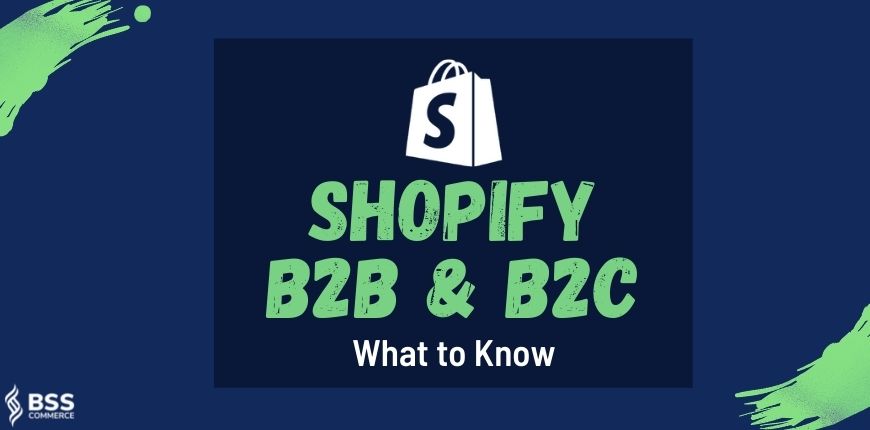The distinction between Shopify B2B and B2C, at first glance, seems insignificant. Externally, online stores often look similar in both cases and have a lot in common.
However, the contrast in the business processes and functionality are of a systemic nature. They differ remarkably in the B2B segment compared to the B2C one. Shopify B2B commerce is distinguished from B2C by the type of client, the audience with which the company works, and its staff.
Also, in B2C deals, rates are lower, the sales cycle is faster and more accessible, and the number of decision-makers is less than in B2B. According to Statista, B2B eCommerce gross merchandise volume has doubled in five years. Now it is six times bigger than B2C eCommerce.
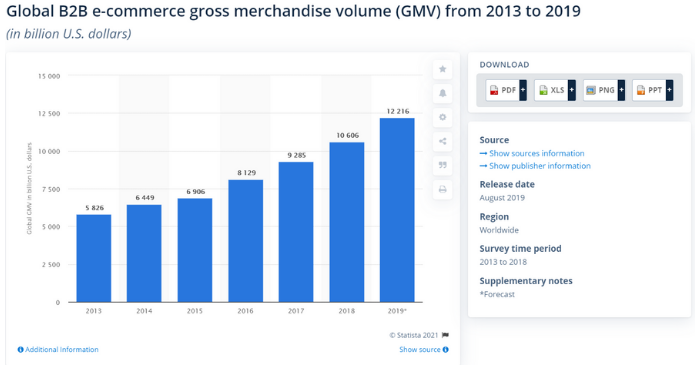
We’ll go into more detail in this article to see if Shopify is as suitable for B2B sales as it is for B2C and whether it can offer modern solutions like headless commerce.
Over 1 million eCommerce websites are designed with the help of Shopify, more than 7,000 of which are B2B eCommerce brands that use Shopify Plus. The grand names include Nestle, Pepsi, and General Electric.
The B2B sector has such a small share compared to B2C because Shopify is excellent for medium and small stores, for which speed and ease of development are essential. For large enterprises, the ability to customize the site is a priority, which Shopify doesn’t fully allow.
Let’s take a look at the example of the official Shopify theme store. We see 75 themes in the catalog, so many businesses have to use the same layout. It may be difficult for online store owners to differentiate sites from their competitors. It can create bottlenecks for enterprises to build brand awareness.
Among this variety of themes, some can be suitable both for stores with an extensive catalog of products, as well as those with a single product. When we go down to the industry block, we notice no separation for Shopify B2B and B2C.
However, companies who need just the layout can use a ready-made template and stick to the original themes. As an alternative, they can hire someone to do the coding to customize the store’s look.
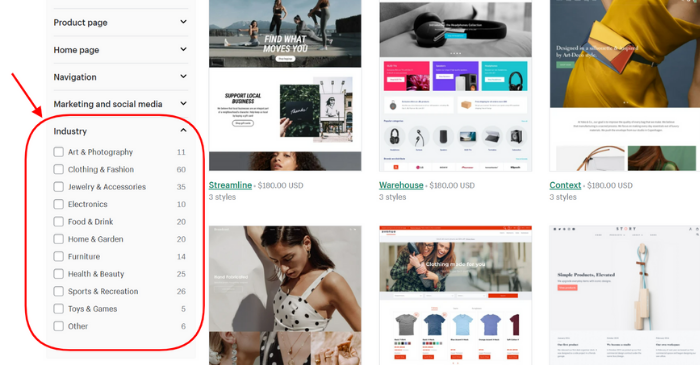
What Does the Shopify B2B Ecosystem Offer?
Shopify proposes a different approach to B2B online stores than to B2C ones. While the situation with B2C is relatively standard and self-explanatory, let’s overview the opportunities Shopify has for B2B sales.
1. Third-Party Wholesale Application
If the pricing model is relatively simple and merchants want the same online store to serve all customer groups (B2C and B2B), there is an option. It involves installing a third-party B2B app on Shopify.
Navigation, product range, shipping, and payment methods don’t differ between Shopify B2B and B2C in this scenario.
2. Shopify Wholesale Channel
For merchants using Shopify Plus, there is the option to set up a dedicated Shopify for B2B sales channel. They can create price lists for specific customer groups and define pricing for particular products at a fixed price.
Unfortunately, price lists restrict full automation. They need to be imported via a CSV file, but not via the Shopify API. The sales channel settings determine navigation, assortment, payment. At the same time, layout editing and language versions are minimal.
3. Independent Shopify B2B Online Store
One more path for Shopify B2B customers is to create a separate Shopify online store. This way, corporate customers can receive more targeted marketing messages. Again, Shopify offers to improve the pricing logic with a wholesale app.
A separate Shopify webstore includes various catalogs and promotions across different stores. The solution works best from a service perspective if the pricing models are relatively uncomplicated and don’t change, especially if the product list is extensive.
4. Separate Registration
Let’s compare the differences between Shopify solutions for B2B and B2C. The B2B/Wholesale Solution offers a different way to register and validate different types of customers. Since the order volume of Shopify B2B and B2C is significantly different, B2B customers often need to pass a credit check.
Customized registration can be observed in the example of the seller of men’s grooming supplies, Beard & Blade, that decided to craft their website with the help of Shopify.
The screenshots show that a name and email address are enough to register as an individual customer. Wholesalers, in turn, have to fill in more fields when registering.
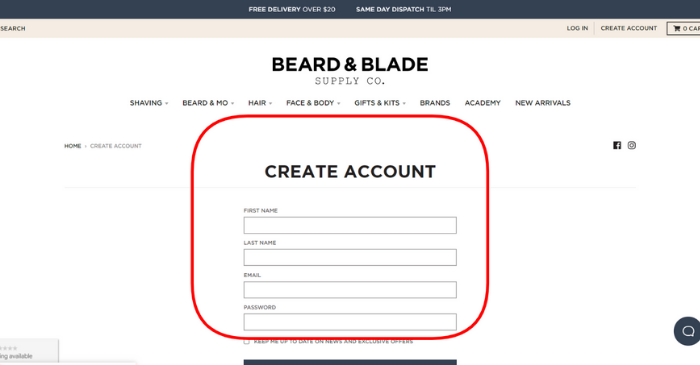
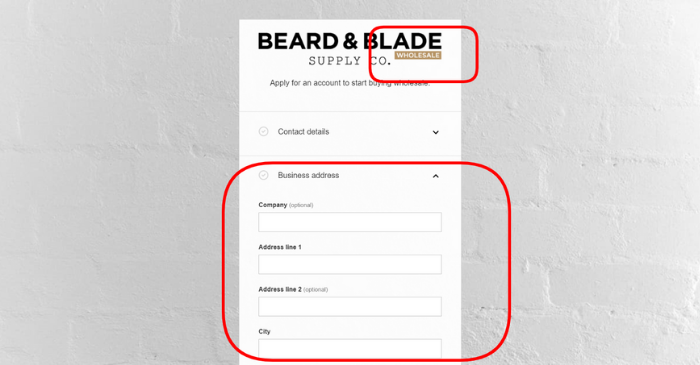
Screenshots taken on the Beard & Blade website
5. Tier Discount Depending on the Order Volume
Another feature that Shopify provides B2B businesses is various discounts for different order volumes. In other words, businesses can create fixed discounts for a certain amount of products.
The larger the order for B2B, the greater the cut price. There is no such solution for B2C since the site usually presents a regular discount tag.
The example of a discount in the Tropeaka store shows this phenomenon.

Screenshot taken on the Tropeaka website
6. Certain Conditions for Customer Checkout
The following Shopify for B2B functionality is the minimum order amount. This is a solution that’s handy for those businesses which restrict the order volume for B2B clients. I.e., an order can be processed only when it reaches the minimum size. And the buyer won’t be able to go to the checkout page.
B2C sales have a different organization. But to increase orders, it is common that stores provide free shipping when a client spends a certain amount of money. You can see this example in the screenshot taken on Shopify’s obtainer, HiSmile, store website below.
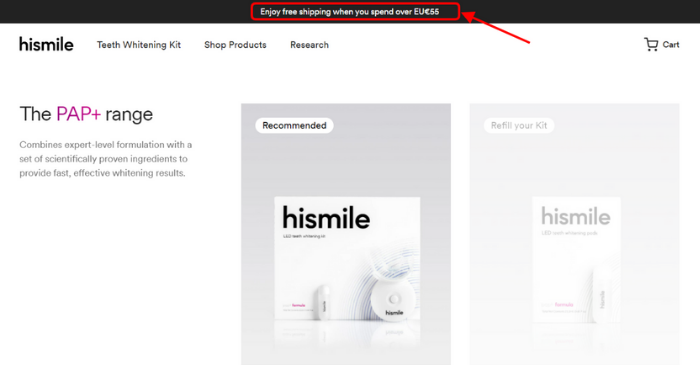
What Shopify B2B And B2C Brands Should Do to Optimize User Experience
1. Creating Content That Educates
Shoppers are now looking for content available online to help them in the buying process, rather than reaching out to salespeople directly.
Therefore, both B2B and B2C brands need to invest in creating content that will help buyers make important buying decisions. To attract existing B2B customers and potentials to the site, the created content should:
- increase the value of the target audience;
- educate potential buyers;
- solve their problems;
- be gripping and informative.
For example, some brands create tutorials. We will look at this phenomenon in the case of the American cosmetics brand CoverGirl, which Shopify powers.
They made a separate section on their B2C website and put a link to it at the top. So customers can get makeup tips and also see the brand’s products in action.
In the screenshot, we can see that information can be filtered by section, and each of them provides links to products.
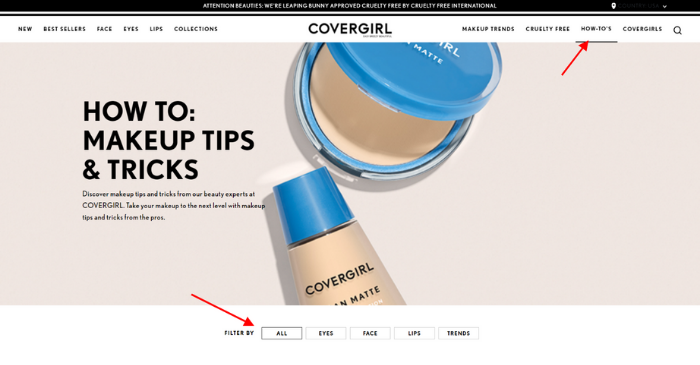
2. Ensuring Smooth Site Search
Shopify B2B and B2C buyers load your website and do online research before making a purchase. Therefore, you should consider having advanced search functionality on your site. Most customers crave ease of finding products when shopping online.
Otherwise, you risk losing quality leads and profits. By providing visitors with instant results, you will be able to attract more clients and interact better with them.
American apparel brand, Bombas, which developed its eCommerce store on Shopify, included a search console on its website so that visitors could directly surf to the needed item. They allow an advanced search solution for their visitors, showing instant search suggestions and synonymous results.
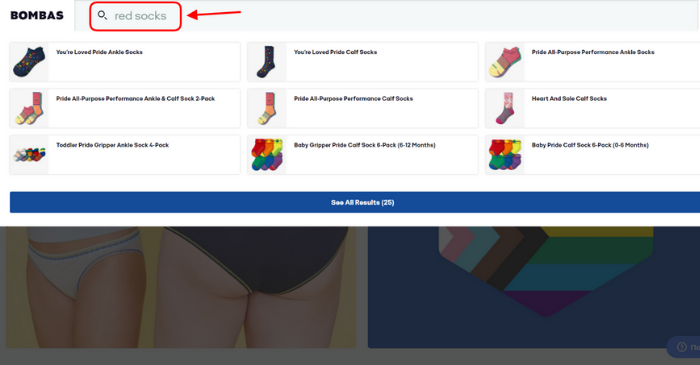
This type of search illustrates products that aren’t 100% coinciding with the request and permits similar products. It is crucial for online stores since it will enable you not to lose clients if they haven’t found exactly what they need.
Shopify app store provides a scope of tools for intelligent search and advanced filters to help shoppers get what they want.
3. Developing Channels Beyond the Website
The following strategy is the necessity to pay attention to online reviews as well as social media marketing and looking beyond the website. Over the past year, people have switched to social media, and now it’s easier to find a way to increase the company’s presence on various platforms.
How you can grab the user’s attention online and create a picture of the company will mean how greatly customers will trust your brand. That’s why your Internet presence should be consistent and reinforce the message conveyed by the website.
A fitness apparel and accessories brand, Gymshark, which works on Shopify, enjoys a highly engaged social media following. You can check out how they connect their Instagram shop and allow users to continue shopping on the web right from social media on the screenshot below.
Also, they showcase all their social channels at the right bottom of the page on their store website.

One more way modern eCommerce store owners reach audiences across multiple platforms is using headless commerce.
It means separating the frontend from the backend and creating your stores in such a way that would make it easy to shop on various devices (smartphones, tablets, using a smart TV, refrigerator, and other interior items of your customers).
Unfortunately, Shopify is currently not fully able to provide such solutions for its customers, and this is the future of eCommerce for the next ten years and beyond. The thing is, Shopify has restrictions for code customization (as opposed to other platforms such as Magento).
It means that there may be obstacles if a store owner wants to decouple the site’s frontend from the backend to create an omnichannel solution.
4. Maintaining Relevant Design Features
It is crucial to consider the differences in building a strategy when developing a Shopify B2B B2C website.
When it comes to content, the distinguishing features of B2C sites are catchy and short titles. You shouldn’t overload the site with excessive content either. Your site must strive to be unique and user-friendly, with a minimum number of steps between clicking the “Buy” button and making a payment.
Unlike B2C, B2B site users are looking for as much information as possible. Therefore, the site should provide the utmost details, and the uniqueness of the design isn’t a priority. The user should see enough CTAs and various types of content ranging from technical documents and blogs to explaining videos and testimonials.
Customers need trust in your site, that you can solve their problem, and that the product or service is compatible with their company. Therefore, it is vital to include specifications, API information, and integration details.
For example, Shopify B2B client, Death Wish Coffee, offers detailed product information on their pages. It uses contrasting CTAs and provides a playground for active discussion and feedback.
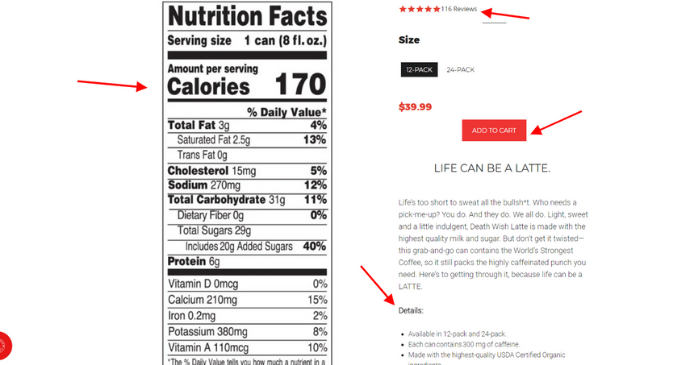
Wrapping Everything Up
Shopify offers a wide range of choices for standard eСom businesses.
Thousands of online stores choose it due to the ease of creating a website. Yet, there are various types of B2B industries. For wholesalers who are interested in having a full-scale store with dozens of product pages on their website, Shopify will help a lot.
However, it is doubtful whether Shopify will be suitable for a B2B business selling services. Therefore, wholesale businesses often choose Shopify. They can be both Shopify B2B and B2C enterprises simultaneously, but the purchase conditions will differ. Most likely, if you are selling online services, hosting, and something else, the choice towards Shopify is not so straightforward.
While there are significant differences between Shopify B2B and B2C eCommerce, these ways of doing business have similarities. You can extract several ideas from some of the concepts above to apply to B2B and B2C eCommerce situations.
Shopify has long been a platform suitable for direct consumer sales and lacked what other B2B sales solutions had. Nevertheless, now it is in the active phase of developing B2B extensions and apps to satisfy any consumer needs.
This article has shown the difference between Shopify B2B and B2C, and we hope you found our tips helpful.
